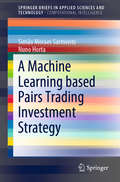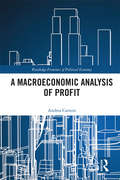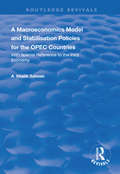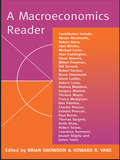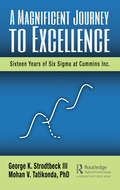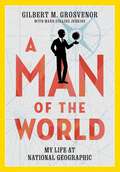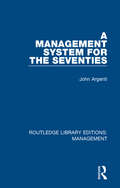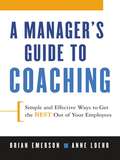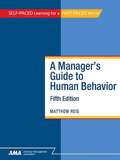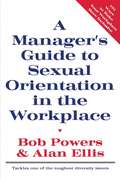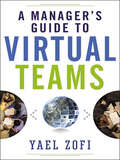- Table View
- List View
A Long, Bumpy and Unfinished Road: Education Reform in Memphis, Tennessee
by Nithya Vaduganathan Allen S. Grossman. J. Puckettcase
A Lost Art: Business Etiquette with Exceptional Service
by James E. AlstonThis book talks about training staff, having the least amount of surprise turnover of employees, and the benefit to keeping customers wowed. This book is a reminder and inspiration to customers, employees, and employers to engage in practical business etiquette for common betterment.
A Machine Learning based Pairs Trading Investment Strategy (SpringerBriefs in Applied Sciences and Technology)
by Nuno Horta Simão Moraes SarmentoThis book investigates the application of promising machine learning techniques to address two problems: (i) how to find profitable pairs while constraining the search space and (ii) how to avoid long decline periods due to prolonged divergent pairs. It also proposes the integration of an unsupervised learning algorithm, OPTICS, to handle problem (i), and demonstrates that the suggested technique can outperform the common pairs search methods, achieving an average portfolio Sharpe ratio of 3.79, in comparison to 3.58 and 2.59 obtained using standard approaches. For problem (ii), the authors introduce a forecasting-based trading model capable of reducing the periods of portfolio decline by 75%. However, this comes at the expense of decreasing overall profitability. The authors also test the proposed strategy using an ARMA model, an LSTM and an LSTM encoder-decoder.
A Macro Model of the Credit Channel in a Currency Union Member: The Case of Benin
by Issouf SamakeA report from the International Monetary Fund.
A Macroeconometric Model for Saudi Arabia: A Case Study on the World’s Largest Oil Exporter (SpringerBriefs in Economics)
by Fakhri J. Hasanov Frederick L. Joutz Jeyhun I. Mikayilov Muhammad JavidThis Open Access Brief presents the KAPSARC Global Energy Macroeconometric Model (KGEMM). KGEMM is a policy analysis tool for examining the impacts of domestic policy measures and global economic and energy shocks on the Kingdom of Saudi Arabia. The model has eight blocks (real sector, fiscal, monetary, external sector, price, labor and wages, energy, population, and age cohorts) that interact with each other to represent the Kingdom’s macroeconomy and energy linkages. It captures New Keynesian demand-side features anchored to medium-run equilibrium and long-run aggregate supply. It applies a cointegration and equilibrium correction modeling (ECM) methodology to time series data to estimate the model’s behavioral equations in the framework of Autometrics, a general-to-specific econometric modeling strategy. Hence, the model combines ‘theory-driven’ approach with ‘data-driven’ approach. The Brief begins with an introduction to the theoretical framework of the model and the KGEMM methodology and then walks the reader through the structure of the model and its behavioral equations. The book closes with simulations showing the application of the model. Providing a detailed introduction to a cutting-edge, robust predictive model, this Brief will be of great use to researchers and policymakers interested in macroeconomics, energy economics, econometrics, and more specifically, the economy of Saudi Arabia.
A Macroeconomic Analysis of Profit (Routledge Frontiers of Political Economy)
by Andrea CarreraBased on the observation of economic reality, this book provides for the foundations of a new structure of national payment systems. Specifically, to this end, a rigorous accounting for money transactions, savings, and invested profit is suggested, with a major aim to settle sustainable lending levels. Profit lies at the heart of economic activities. Indeed, companies, from small to large, seek net gains to remunerate shareholders and to increase their assets. Yet, economists are far from sharing a common theory of profit. Using mathematical tools and a discursive approach, this book contributes to the debates in such regard, in the attempt to provide new answers to old economic issues. What is macroeconomic profit? Is there any relationship between wages, lending, and profit? This book is an accesible resource for economists and financial experts as well as global economics students, researchers, academics and historians alike. It will challenge policy-makers and professionals and lead them on a thought-provoking journey through the realm of macroeconomics.
A Macroeconomic Regime for the 21st Century: Towards a New Economic Order
by Christopher TaylorThe book aims to give non-economists a detailed understanding of how macroeconomic policy works in modern economies, and the issues it faces. The world has recently been through a huge economic crisis and thinking people everywhere have reason to wonder whether something is not seriously wrong with the policy regimes underlying these dramatic events in the major economies, and whether changes should be made. The author reviews the history of the successive regimes tried and found wanting in the second half of the last century and proposes a set of reforms designed to convert the flawed neo-liberal consensus of the 1990s into a durable regime for the present century.
A Macroeconomics Model and Stabilisation Policies for the OPEC Countries: With Special Reference to the Iraqi Economy (Routledge Revivals)
by A. Khalik SalmanFirst published in 1999, this book focuses on the macroeconomics issues which directly affect OPEC countries, aiming to set them in the context of the overall development effort. The most extant theoretical and empirical aspects in macroeconomics are integrated smoothly with institutional issues and policy questions. The analysis is illustrated through examples to show how the theories relate to the real world, especially to ongoing debates on developing economies as well as debates that encompass both developing and OPEC and developed countries.
A Macroeconomics Reader
by Howard Vane Brian SnowdonA Macroeconomics Reader brings together a collection of key readings in modern macroeconomics. Each article has been carefully chosen to provide the reader with accessible, non-technical, and reflective papers which critically assess important areas and current controversies within modern macroeconomics.The book is divided into six parts, each with a separate introduction highlighting the relevance of the ensuing articles. The areas covered include: Keynes's General Theory, Keynesian economics and the Keynesian revolution; monetarism; rational expectations and new classical macroeconomics; real business cycle approaches: New Keynesian economics: economic growth.This book will be an essential guide for students and lecturers in the field of macroeconomics as well as those interested in the history of economic thought.
A Mad Love: An Introduction to Opera
by Vivien SchweitzerA lively introduction to opera, from the Renaissance to the twenty-first centuryThere are few art forms as visceral and emotional as opera-and few that are as daunting for newcomers. A Mad Love offers a spirited and indispensable tour of opera's eclectic past and present, beginning with Monteverdi's L'Orfeo in 1607, generally considered the first successful opera, through classics like Carmen and La Boheme, and spanning to Brokeback Mountain and The Death of Klinghoffer in recent years. Musician and critic Vivien Schweitzer acquaints readers with the genre's most important composers and some of its most influential performers, recounts its long-standing debates, and explains its essential terminology. Today, opera is everywhere, from the historic houses of major opera companies to movie theaters and public parks to offbeat performance spaces and our earbuds. A Mad Love is an essential book for anyone who wants to appreciate this living, evolving art form in all its richness.
A Magnificent Journey to Excellence: Sixteen Years of Six Sigma at Cummins Inc.
by George K. Strodtbeck III Mohan V. Tatikonda PhDThis book presents a model of organization transformation success. The model framework comprises a series of S-Curves (maturity curves) of planning and execution activities phased over time. The model is illustrated through description and analysis of an actual, two-decade, highly successful, global enterprise transformation Six Sigma program at a Fortune 200 company: Cummins, Inc. Lessons learned from the model and company case study are completely transferrable to other organizational culture, improvement and innovation transformation settings. This insightful book: • Documents a firsthand account of a successful transformation. The authors completely explain what was accomplished and the lessons learned from a 16-year deployment of Six Sigma at Cummins. • Acts as a benchmark for those organizations interested in pursuing primarily a continuous improvement transformation, and more generally for other types of transformation efforts. • Includes substantive interviews with ten key leaders and others who made the transformation possible. • Helps organizations shorten the overall transformation timelines. The documentation of a transformation provides you a model for how to think about organization transformation maturity over time and plan for it. • Recognizes the work of thousands of people involved in transforming a global company. The interviews provide extraordinary perspectives not only by executives who initiated and sustained the transformation program but also by program participants who themselves grew as managers and leaders in their careers through the program. Essentially, this book helps early-career managers and executives see the broader picture of enterprise transformation, especially over time. This helps them be better managers and executives, and importantly, helps them better plan for and hasten their upward career trajectories. Lastly, the book describes a view of possibilities. It describes a clear, sustained success, the steps taken to get there and the measurement of progress. The result provides you with confidence that successful transformation is possible and worth the effort.
A Man and His Mountain: The Everyman who Created Kendall-Jackson and Became America's Greatest Wine Entrepreneur
by Humes9781610392853
A Man for All Markets: Beating the Odds, from Las Vegas to Wall Street
by Edward O. ThorpA New York Times bestseller In a remarkable career, Edward O. Thorp rose up from nothing to become a professor at MIT, invented card counting and the world&’s first wearable computer, beat the casinos of Las Vegas at blackjack and roulette, then became a bestselling author and a hedge fund heavyweight, ushering in a revolution on Wall Street. Now he shares his incredible life story for the first time, revealing how he made his fortune and giving advice to the next generation of investors. An intellectual thrill ride, replete with practical wisdom, A Man for All Markets is a scarcely imaginable tale of ludicrous success.
A Man for All Markets: From Las Vegas to Wall Street, How I Beat the Dealer and the Market
by Nassim Nicholas Taleb Edward O. ThorpThe incredible true story of the card-counting mathematics professor who taught the world how to beat the dealer and, as the first of the great quantitative investors, ushered in a revolution on Wall Street. A child of the Great Depression, legendary mathematician Edward O. Thorp invented card counting, proving the seemingly impossible: that you could beat the dealer at the blackjack table. As a result he launched a gambling renaissance. His remarkable success—and mathematically unassailable method—caused such an uproar that casinos altered the rules of the game to thwart him and the legions he inspired. They barred him from their premises, even put his life in jeopardy. Nonetheless, gambling was forever changed. Thereafter, Thorp shifted his sights to “the biggest casino in the world”: Wall Street. Devising and then deploying mathematical formulas to beat the market, Thorp ushered in the era of quantitative finance we live in today. Along the way, the so-called godfather of the quants played bridge with Warren Buffett, crossed swords with a young Rudy Giuliani, detected the Bernie Madoff scheme, and, to beat the game of roulette, invented, with Claude Shannon, the world’s first wearable computer. Here, for the first time, Thorp tells the story of what he did, how he did it, his passions and motivations, and the curiosity that has always driven him to disregard conventional wisdom and devise game-changing solutions to seemingly insoluble problems. An intellectual thrill ride, replete with practical wisdom that can guide us all in uncertain financial waters, A Man for All Markets is an instant classic—a book that challenges its readers to think logically about a seemingly irrational world.Advance praise for A Man for All Markets“An amazing book by a true icon . . . Edward O. Thorp launched revolutions in Vegas and on Wall Street by turning math into magic, and here he weaves his own life lessons into a page-turner as hot as a deck full of aces. Loved it!”—Ben Mezrich, New York Times bestselling author of Bringing Down the House and The Accidental Billionaires “Whether you are an aspiring professional player, a casual gambler, or an occasional visitor to Las Vegas, you can feel the impact of Edward O. Thorp’s intellect on that desert city. In 1962, Thorp published the classic book Beat the Dealer. The text was based on Thorp’s original research that stemmed from his curiosity about the game of 21 and was billed as a how-to book for the layperson to beat the casinos at blackjack. Simply stated, it changed everything. A Man for All Markets chronicles Thorp’s personal journey in navigating the unexpected and sometimes dangerous obstacles that come along with challenging the status quo of a wealthy corporate adversary.”—Nicholas G. Colon, professional advantage gambler and managing director, Alea Consulting Group “What a CV! Figure out how to win at blackjack using card counting? Check. Build the world’s first wearable computer? Check. Find the formula for valuing financial options but use it to make money rather than win a Nobel Prize? Check. This book is in part the gripping story of how one man’s genius and dedication has solved so many problems in diverse fields. But more important, it’s a fascinating insight into the thought processes of someone with little interest in fame, who has mostly stayed under the radar, yet who has followed his inquisitive mind wherever it has led him, and reaped the resulting rewards. There is nothing more important than knowing how to think clearly. Read this book and learn from a master.”—Paul Wilmott, founder, Wilmott magazine
A Man of the World: My Life at National Geographic
by Gilbert M GrosvenorThe captivating inside story of the man who helmed National Geographic over the course of six decades is a front-row seat to iconic feats of exploration, from the successful hunt for the Titanic to Jane Goodall's field studies, offering a rare portrait of one of the most iconic media empires in history and making an impassioned argument for our enduring need to know and care for our world.Though his career path had been paved by four generations of his family before him, Gilbert M. Grosvenor left his own mark on the National Geographic Society, founded in 1888 and recognised the world over by its ubiquitous yellow border. In an unflinchingly honest memoir as big as the world and all that is in it, Grosvenor shows us what it was like to "grow up Geographic" in a family home where explorers like Robert Peary, Louis Leakey, and Jane Goodall regularly crossed the threshold. As staff photographer, editor in chief and then president of the organisation, Grosvenor oversaw the diversification into television, film, books, as well as its flagship magazine, which under his tenure reached a peak circulation of nearly 11 million. He also narrates the shift from a nonprofit, family-focused enterprise to the more corporate, bottom-line focused world of publishing today.For Grosvenor, running National Geographic wasn&’t just a job. It was a legacy, motivated by a passion not just to leave the world a better place, but to motivate others to do so, too. Filled with world travel, charismatic explorers, and the complexities of running a publishing empire, A MAN OF THE WORLD is the story of one man, a singular family business, and the changing face of American media.
A Man's Reach
by Elmer L. Andersen Lori SturdevantAutobiography of the popular Minnesota Governor in the 1950's.
A Management System for the Seventies (Routledge Library Editions: Management #1)
by John ArgentiOriginally published in 1972. This book was designed to help those in positions of management during the 1970s. The author attempted to predict what problems managers would face during that period, and suggested a practical system of management designed to help them cope with these problems. Many of these suggestions can certainly still be applied to management today. This book is intended for managers in all types of organizations – including those in business, industry, and commerce – as well as students on business and management courses.
A Manager's Guide to BS25999
by Tony DrewittThis book is a concise and practical guide to implementing the new benchmark for business continuity management - BS25999. While the number of events that could potentially disrupt the ability of your organization to continue with its business activities continues to grow, the ramifications are increasingly dramatic. Climate change, terrorism and IT system failure are just some of today's more serious threats - and pressure is growing on all organizations to demonstrate effective, meaningful and dependable emergency preparedness. This guide will help you understand and meet the growing need to demonstrate and provide assurance to partners, customers and stakeholders that, should some significant business disruption occur, you have done everything possible to minimize disruption to the continued supply of the products or services by your organization.
A Manager's Guide to Coaching: Simple and Effective Ways to Get the Best From Your People
by Brian Emerson Anne LoehrTo stay on top, companies need to do more than just tread water—they need to grow. And that means that their employees need to develop and improve their skills at the same pace. More than ever, managers are being encouraged to improve employee performance through effective coaching, but so few of them have the time—or the knowledge—it takes to do it successfully. Brian Emerson and Ann Loehr have spent years showing some of the country’s top companies how to develop their most promising employees. Now in this helpful manual they guide managers through every step of the coaching process, from problem solving to developing accountability. Readers will discover:the top 10 tips every manager should know before he starts to coach • how to handle difficult conversations, conflicting priorities, and problem team members • how to hold follow-up meetings after goals and priorities have been set • sample questions they can adapt to various situations • examples of common problems and how they can use coaching to address them.Clear, practical and straightforward, this is an invaluable tool that will help all leaders coach employees, colleagues, and themselves to excellence.
A Manager's Guide to Human Behavior, Fifth Edition
by Matthew Reis Judith GellerUnderstanding how and why employees behave as they do is a critical skill for managers in every organization. Managers are responsible for ensuring that the organization’s mission and strategic goals are enacted, so it is of the utmost importance they know how motivate and engage employees. This updated and revised edition of A Manager’s Guide to Human Behavior will prepare managers to better understand, motivate, and focus the energies of individual employees and the collective energy of their work teams. Building on the content in the fourth edition, this updated course reexamines key theories and focuses on their practical application to typical management situations. New topics is this edition include learning organizations and open systems, as a context for understanding how individuals contribute to organizational effectiveness; self-awareness; Goleman’s emotional intelligence; and Bridge’s transitions model of change. The performance management section has been enhanced with a simplified process model (define, develop, review and reward), and the section on leadership examines the concept of the versatile leader who engages the spirit, head, heart, and hands of employees. Throughout the course, self-assessments, worksheets, checklists, and questionnaires give students the opportunity to apply what they are learning. Each chapter incorporates an action plan tied to the objectives and competencies for the topic area. Short case studies enable students to apply their new knowledge to analyze, understand, and influence human behavior.
A Manager's Guide to ISO22301
by Tony DrewittHave you ever wondered whether your business continuity plan is any good, or whether youve even got a business continuity plan? Anyone can write a simple document, call it a business continuity plan and hope for the best. But, unless you know that it will do what it is supposed to, it may be a wasted investment. This practical guide to the ISO22301 business continuity management system standard shows you how to develop and implement a business continuity management (BCM) and disaster recovery plan; ensuring you get back on your feet with the minimum of fuss, should the unthinkable happen. Providing a comprehensive introduction to the topic, this book includes practical, detailed guidance on developing and implementing a BCM system certifiable to the ISO22301 standard, using detailed and illustrative examples. A BCM policy and other useful document templates are provided in the appendices. As an international standard, ISO22301 is likely to become the benchmark that is used to judge how a business will cope with disaster. Although only some public bodies are required by law to have business continuity plans, an ISO22301 compliant system will give you peace of mind, reassure your customers and business partners and help you to meet your legal obligations. Disaster can strike without warning, so the time to start developing an ISO22301 compliant system is now. This book is the perfect place to start. Tony Drewitt has specialised in operational risk management and business continuity since 2001 and is currently working with several organisations to develop management systems in line with ISO22301 and its predecessor BS25999. He has written several books on business continuity including BS25999: A Pocket Guide, A Managers Guide to BS25999 and Everything You Want to Know About Business Continuity.
A Manager's Guide to PR Projects: A Practical Approach (Lea's Communication Ser.)
by Patricia ParsonsA Manager's Guide to PR Projects, Second Edition picks up where classic public relations textbooks leave off. It provides hands-on guidance in planning the preliminary research for a public relations project and creating a plan to achieve specific goals, guiding the reader through managing the project's implementation. It contains worksheets that can be used for a visual representation of the planning process for both student edification and presentation to clients. The book is designed as a user-friendly guide to take the reader through the four-step public relations planning process from a number of vantage points. Intended as a learning tool for use in both the class and beyond, this book's approaches are based on real experiences in the management of communications projects designed to meet organizational goals through achieving public relations objectives. This fully revised second edition offers PR students and practitioners new material that includes the following: The impact of social media on each phase of the planning process. Digital approaches to strategic and summative research, message dissemination and public engagement. Strategies to enhance accountability. Ethics considerations in the planning process. Updated print and web-based resources for PR managers.
A Manager's Guide to Sexual Orientation in the Workplace
by Bob Powers Alan EllisFor the first time ever, managers will have a tool that will enable them to effectively grapple with the controversial, and sometimes explosive issues surrounding sexual orientation. Cultivated from Bob Power's 25 years business experience with some of the world's finest organizations, A Manager's Guide to Sexual Orientation in the Workplace provides managers with the knowledge, skills and resources to foster higher productivity and performance through an all-inclusive work environment.
A Manager's Guide to Virtual Teams
by Yael ZofiYael Zofi&’s proprietary Trust Wheel model is a proven solution to the unique challenges managers must overcome as more people migrate to partially or fully-remote working situations.Based on the author&’s twenty-plus years of consulting experience, this powerful tool encourages cohesiveness and engagement among team members--even if they&’ve never met. A Manager&’s Guide to Virtual Teams does this by providing a practical road map for bridging the physical distance among coworkers, incorporating self-study exercises and simple, fun activities that develop trust and ensure your team&’s success.The book explores the most critical elements to success for a team founded in trust, including:accountability,communication,conflict management,and deliverables.Complete with examples, case scenarios, and strategies to help you navigate even your biggest hurdles, A Manager&’s Guide to Virtual Teams will help your disparate collection of people get their work &“out the door&” faster and better.
A Manager's Guide to the New World of Work: The Most Effective Strategies for Managing People, Teams, and Organizations (The Digital Future of Management)
by MIT Sloan Management ReviewThe best tools and insights to succesfully navigate the novel challenges of the digital workplace.How can technology and analytics help companies manage people? Why do teams working remotely still need leaders? When should organizations use digital assessment tools for gauging talent and potential? This book from MIT Sloan Management Review answers questions managers are only beginning to ask, presenting insights and stories from organizations navigating the novel challenges of the digital workplace. Experts from business and academia describe what's worked, what's failed, and what they've learned in the new world of work, looking at strategies that organizations use to help managers and employees adapt to the fast-changing digital environment.


